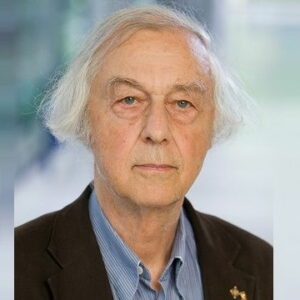Robert Huber is a biochemist from Germany who won the 1988 Nobel Prize in Chemistry for determining the three-dimensional structure of a photosynthesis reaction center. He was presented with the award alongside Johann Deisenhofer and Hartmut Michel. Huber, who was raised during the World War II era when survival and daily bread seemed to be a constant struggle, did not let societal problems get in the way of his education. He attended Humanistisches Karls-Gymnasium for his early education. Huber educated himself in Latin, Greek, natural sciences, and grammar in this volume. Huber first encountered chemistry during his high school years. Intrigued by the subject, he devoured all available chemistry books and quickly earned a diploma in the subject. He earned his doctorate from Munich Technical University and later worked at Germany’s Max Planck Institute for Biochemistry in Martinsried. He conducted his award-winning research with Deisenhofer and Michel at Max Planck. He worked there and at the Munich Technical University on a rotating basis. Huber is currently a Professor Emeritus of Excellence at Munich Technical University.
Childhood & Adolescence
Robert Huber was born in Munich, Germany, on February 20, 1937, to Sebastian and Helene Huber. His father worked as a cashier in a bank. Robert grew up with a younger sister.
Huber received his early education from 1947 to 1956 at Humanistisches Karls-Gymnasium. His fascination with chemistry began then, as he devoured all chemistry books he could get his hands on. Huber later earned a diploma in chemistry from the Technische Hochschule in 1960.
Following his graduation, Huber pursued research, utilizing crystallography to elucidate the structure of organic compounds. His research earned him a stipend from the Bayerisches Ministerium für Bildung und Kultur and later from the Studienstiftung des Deutschen Volkes, which helped him overcome financial difficulties.
Huber continued his education at the Munich Technical University, where he earned a doctorate in 1963 with a thesis on the crystal structure of a diazo compound.
Career of Robert
Robert Huber’s PhD thesis on the crystal structure of a diazo compound influenced a large portion of his subsequent work as he became aware of crystallography’s power. He advanced his career in the same direction by conducting crystallography research.
Huber spent the majority of his time in the laboratories of Hoppe and Karlson at the Physiologisch-Chemisches Institut der Universität München, where he worked on crystallographic studies of the insect metamorphosis hormone ecdysone.
During his time at Karlson’s laboratory, he discovered the molecular weight and probable steroid nature of ecdysone through a simple crystallographic experiment. Huber continued his research in the field of crystallography as a result of this discovery.
With the support of Hoppe and Braunitzer, Huber began his crystallographic work on the insect protein erythrocruorin (with Formanek) in 1967.
Huber began research on the basic pancreatic trypsin inhibitor in 1970. It eventually served as the model compound for other laboratories’ development of protein NMR, molecular dynamics, and experimental folding studies.
Huber accepted a chair of structural biology at the Biozentrum and the directorship of the Structure Research department at the Max-Planck Institute for Biochemistry from the University of Basel in 1971, positions he held until 2005. Simultaneously, he maintained an affiliation with Munich Technical University, where he was appointed adjunct professor in 1976.
Huber spent the first half of the 1970s studying immunoglobulins and their fragments, which culminated in the elucidation of several fragments, an intact antibody, and its Fc fragment, the first glycoprotein to undergo atomic-level analysis. He later expanded his research to include proteins that interact with immunoglobulins.
Huber began investigating proteins involved in excitation energy and electron transfer in the 1980s, as well as light-harvesting proteins, bilin-binding proteins, and ascorbate oxidase. Huber discovered that some proteins exhibited large-scale flexibility while studying these. The study, however, was not immediately accepted by the scientific community.
In 1985, Robert Huber and his colleagues Johann Deisenhofer and Hartmut Michel succeeded in determining for the first time the three-dimensional structure of photosynthesis reaction centers. The discovery was revolutionary because it aided in the understanding of the photosynthetic light reaction and the numerous functions of proteins.
Since 2005, he has served as Director Emeritus and Head of the Max Planck Institute of Biochemistry’s Structure Research research group.
He was appointed Emeritus of Excellence at the Munich Technical University in 2013 and has served in that capacity ever since.
Significant Works
Huber’s magnum opus came in the 1980s, when he co-discovered the three-dimensional structure of a photosynthesis reaction centre with Johann Deisehofer and Hartmut Michel. Huber, an internationally renowned expert on the application of X-ray diffraction, determined the atomic structure of complex molecules such as proteins by analyzing how the crystal’s atoms scatter an X-ray beam.
Together with colleagues, he determined the structure of a protein complex that is required for photosynthesis in certain bacteria.
Awards and Accomplishments
Huber received the Otto Warburg Medal in 1977. Huber was co-winner of the 1988 Nobel Prize in Chemistry with Johann Deisenhofer and Hartmut Michel. The trio was recognized for determining the three-dimensional structure of a photosynthetic reaction center.
He was awarded the Sir Hans Krebs Medal in 1992. Huber was elected to Pour le Mérite des Sciences et des Arts in 1993 and to the Royal Society as a Foreign Member in 1999.
Personal History and Legacies
In 1960, Huber married Christa Essig. The couple had four children together, two daughters and two sons. Huber and Christa, on the other hand, parted ways. Huber is currently married to Brigitte Doleshel.
Estimated Net Worth
The netb worth of Robert is $1.4million.


